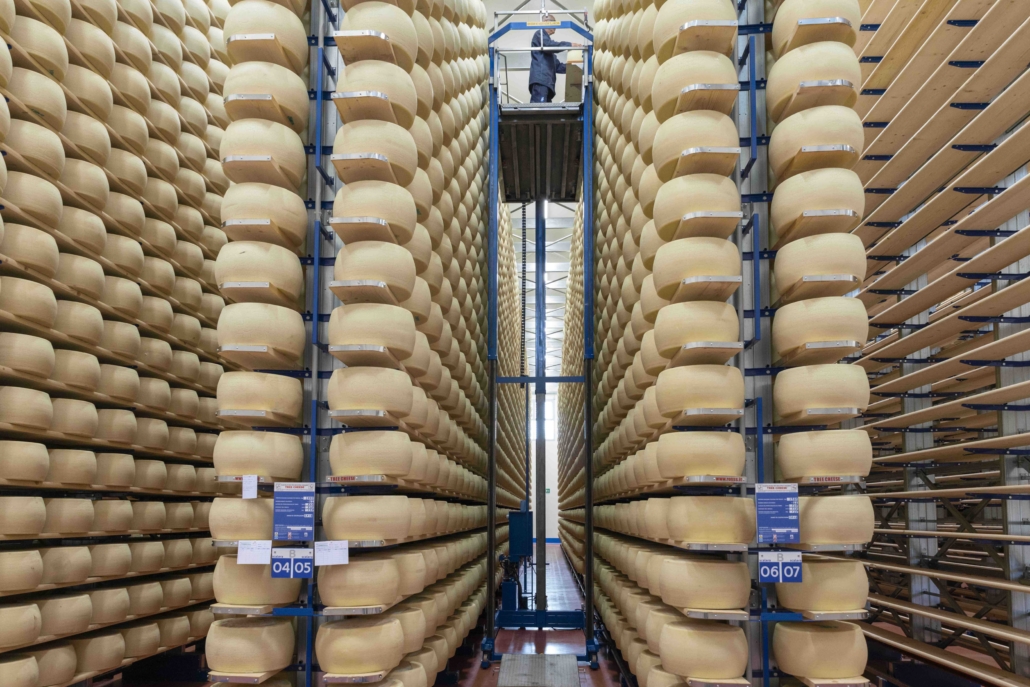Grana Padano stands as one of the most renowned and appreciated cheeses, both in Italy and internationally.
Its grainy texture and long aging period contribute to its position as the fourth best-selling cheese worldwide.
Last year, production exceeded 5 million wheels, reaching 5,246,012 wheels.
The history of Grana Padano is reflected in its origins and production, concentrated in the regions of Lombardy, Piedmont, Veneto, and Emilia-Romagna.
This article aims to explore the fascinating stories behind this iconic dairy product that has conquered the palates of the world.
The History of Grana Padano, from Cisalpine Gaul to the Kings Tables
While the Romans were dedicated to the production of fresh cheeses, in the Cisalpine Gaul, present-day territory of the Po Valley, hard cow’s milk cheeses were created, with a round shape and considerable dimensions.
It is right here that the roots of the first origins of the famous Grana Padano lie.
However, it was around the year 1000 that the production of Grana Padano took on a prominent role, in an era when cheese was considered a food destined exclusively for peasants and the lower classes, who made it to avoid waste of excess milk.
In this medieval context, the important contribution of the monks, in particular in the Chiaravalle Monastery, located about ten kilometers from Milan, stands out.
The 12th century marks the foundation of the Abbey of Santa Maria di Chiaravalle by the Cistercian monks from the Abbey of Cîteaux in Burgundy.
Through deep reflections and experiments, the idea of cooking milk for a long time, adding rennet and then subjecting it to a salting process arises.
Thus, a hard cheese was born, which intensifies its flavor over time and, thanks to its aging, preserves the nutritional principles of milk, its precious raw material.
The History of Grana Padano, a cheese with a rough and robust consistency
This cheese, with its rough and robust consistency, finds its origin in the cauldrons of monasteries, which thus become the precursors of modern dairies.
Under the wise guidance of the monks, new professional figures emerge, the cheesemakers, experts in the art of cheesemaking.
Due to its long aging process, the monks call it “caseus vetus“, translatable as “old cheese“, highlighting its distinction from previous cheeses which, being fresh, required prompt consumption.
Despite this name, the rural population, less accustomed to Latin, prefers to call this cheese “grana” because of its compact paste dotted with white grains, or small residual calcium crystals derived from the transformation of milk.
Grana Padano Testimonials
In addition, the impressions of the celebrated poet Petrarch: “In Parma, Lodigiano, and Piacentino, thanks to the great abundance of milk obtained from the animals in those areas, cheese wheels were sometimes made so large and imposing that they measured two and a half feet in diameter and weighed over three ounces, equal to two hundred common pounds. The cheesemakers shaped the curdled liquid in the cauldrons, giving life to extraordinary edible wheels.“
The fame of “Grana” in the Po Valley region solidified, transforming it into a prized cheese that took on a leading role in the sumptuous Renaissance banquets held by princes and dukes.
Among the testimonies of this era, a letter from Isabella d’Este, wife of Francesco II Gonzaga and Marquise of Mantua, stands out. In 1504, she donated the famous cheese to her relatives, the lords of the Duchy of Ferrara.
Thanks to its rich nutritional properties and its ability to be stored for a long time, Grana Padano proved to be a fundamental food during periods of famine, becoming a symbol of the social and economic culture of the time.
Its appreciation extended, in fact, from the humblest class to the rich and nobles, transforming it into a refined yet simple and traditional product.
From the 1951 Stresa Convention to today
As Italian culinary culture evolved, the need arose to clearly define the characteristics and unique qualities of each food item within the Italian food and wine tradition. Grana Padano, a renowned cheese, stood out in this regard.
The concept of safeguarding Grana Padano’s identity emerged in the early 1900s.
It aimed to transform a generic name into a precise name of origin, conferring unique and inimitable qualities to the product by defining the raw materials, techniques, and procedures for its production.
A turning point came in 1951 in Stresa, during a meeting involving European dairy technicians and operators.
On that occasion, a Convention was signed establishing the first rules on cheese names, particularly regarding the distinction between Grana Padano and Parmesan Cheese.
In 1954, thanks to the initiative of Federlatte and Assolatte, the Grana Padano Cheese Protection Consortium was established.
This organization brought together all producers, ripeners, and traders of this precious cheese, establishing standards concerning production methods, ripening, distinctive characteristics, and the areas of origin of Grana Padano.
The Grana Padano Protection Consortium goes beyond safeguarding the cheese’s quality. It also plays an active role in promoting its consumption. This translates into developing initiatives to support the region, regulating distribution and marketing, not only in Italy but also abroad.
In 1996, Grana Padano earned the prestigious DOP recognition – Protected Designation of Origin from the European Union.
Today, the Consortium boasts the participation of 132 cheesemaking factories, 156 ripeners, and 4,634 milk suppliers, involving a total of 50,000 workers in the entire sector.
The Grana Padano Protection Consortium stands as a testament to Italy’s commitment to preserving its culinary heritage, ensuring the world continues to savor the authentic taste of Grana Padano for generations to come.
Conclusions
Grana Padano is more than just a cheese; it is a testament to Italian cheesemaking mastery, embodying the deep gastronomic traditions of Made in Italy.
With its roots dating back millennia, its current production is subject to rigorous controls and regulations, bestowing upon this cheese an exceptional quality.





